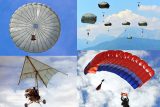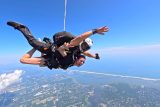Skydiving Weather Conditions: How Can They Affect My Tandem Jump?
Skydiving
Posted by: Long Island Skydiving Center
8 years ago
How important are good skydiving weather conditions, really?
If you get into skydiving, you’ll notice something interesting: The entire sport revolves around calculating risk, reducing variables and taking personal responsibility. (If you thought it was about adrenaline, that’ll be a surprise!)
The first instance in which you’ll notice the calculation of risk will be during the run-up to your first tandem skydive, and it’ll involve that overarching variable of variables: The weather. If you’re playing in the sky, you’re playing in the weather. Weather affects every part of the skydiving experience, from the sun on your face during freefall to the gentleness of your landing.
There are – it goes without saying – certain conditions that prevent us from jumping. When the wind is too strong or the clouds are too thick, our risk-calculating alarms go off. We stay on the ground. Here’s the brief beta on how weather conditions can affect your tandem skydive, just so you’re ready to see it from the expert perspective.
First, a few things you might not be thinking about:
It’s obvious that the best skydives go down (literally!) when the sun is shining, the weather is warm, and the sky is clear and blue. A skydive performed in those conditions is comfortable temperature-wise, with 100% visibility all around. Deviations from that ideal are common and not always unpleasant (some clouds are fun!), but here are the criteria we’re using to evaluate the “go” or “no-go” factor.
- We need to see the ground from the airplane. Low clouds? No jumps. Even though GPS is likely to get us reasonably close to the mark, all expert skydivers know that it’s a wicked-bad call to rely on them. The best tool to evaluate whether you’re getting out in the right place is your very own eyesight – and landing off the dropzone could put a baffled jumper in a tree, a lake or a full parking lot. No bueno.
- We need to be able to control our parachutes during descent. You might just be thinking about the freefall part of your tandem skydive, but there’s a highly necessary parachute component, too, y’know. High winds significantly affect how our parachutes fly, pushing them off-course – and even backwards.
- Can you skydive when it’s raining? You might romanticize the gentle patter of a light rain down on your smiling face, but make no mistake: On a skydive, the pointy ends of those raindrops are sticking up at you as you careen down on them at 120mph. Yeowch.
What weather conditions stop a skydive?
With that in mind: We stop jumping whenever there’s weather conditions that restrict our vision in the sky or make it difficult to control our parachutes on the way down to the ground. That said, we go on a “weather hold” whenever any of the following are true:
- There’s significant cloud cover. Even if the cloud seems broken in places, those “holes” are almost certainly moving around, and unless the Safety and Training Officer at the dropzone determines that there will certainly be a big space directly over the dropzone by the time the plane reaches exit altitude, we jumpers need to wait.
- It’s raining. First of all, rain falls from clouds – a subject we already treated. Even if the source clouds are higher than exit altitude, we tend to wait for the rain to pass because it’s just not worth the misery -and because the weight of the water in the fabric of our parachutes negatively changes the way the parachutes fly.
- It’s quite windy. We have wind speed limits for different solo skydiving licensing levels. If you have a higher-level license, you’re given more latitude to decide what wind speeds you will and will not tolerate. Tandems have more latitude than, say, A-license skydivers because of the high-level professional pilot and the design of the equipment, but we keep our tandem students’ comfort and safety well in mind when we determine a wind hold.
Curious as to find out what the weather is doing at your target dropzone? You guessed it – there’s an app for that! There are several skydiving weather apps – if you’re curious, check out SpotAssist.
What if the weather is too bad for a skydive?
No worries, mate. In the unfortunate event that skydiving weather conditions keeps you down on the day you’d hoped to jump, we’ll simply reschedule your jump for another day. Easy-peasy!
If it’s the afternoon before the day of your reservation and the weather report is growling at you, don’t be a stranger. Get in touch! We’ll be happy to talk to you about how likely it is that you’ll be on a load the following day… and we’ll be doing good-weather dances in your honor.
Categories:
You May Be Interested In:

Skydiving After LASIK: What You Need to Know
8 months ago by Long Island Skydiving Center

What Parachute Types Are There?
8 months ago by Long Island Skydiving Center

How Dangerous is Tandem Skydiving?
10 months ago by Long Island Skydiving Center

Nervous About Skydiving? Here Are Our Top 6 Tips!
10 months ago by Long Island Skydiving Center